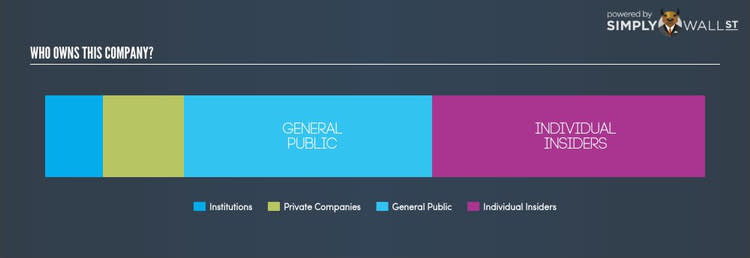Why Acasta Enterprises Inc’s (TSX:AEF) Ownership Structure Is Important

I am going to take a deep dive into Acasta Enterprises Inc’s (TSX:AEF) most recent ownership structure, not a frequent subject of discussion among individual investors. The impact of a company’s ownership structure affects both its short- and long-term performance. Differences in ownership structure of companies can have a profound effect on how management’s incentives are aligned with shareholder returns, which is why we’ll take a moment to analyse XYZ’s shareholder registry. All data provided is as of the most recent financial year end.
See our latest analysis for AEF
Institutional Ownership
Institutional investors transact in large blocks which can influence the momentum of stock prices, at least in the short-term, especially when there is a low level of public shares available on the market to trade. With an institutional ownership of 8.90%, AEF doesn’t seem too exposed to higher volatility resulting from institutional trading. Less covered stocks like AEF used to feature in legendary investor Peter Lynch’s portfolio, which would later be bought up by fast-following institutions as the stock gained more popularity.
Insider Ownership
Insiders form another group of important ownership types as they manage the company’s operations and decide the best use of capital. Insider ownership has been linked to better alignment between management and shareholders. One of the major owners in AEF are individual insiders, sitting with a hefty 41.30% stake in the company. Broadly, insider ownership of this level has been found to negatively affect companies with consistently low PE ratio (underperforming). And a positive impact has been seen on companies with a high PE ratio (outperforming). Another aspect of insider ownership is to learn about their recent transactions. Insiders buying company shares can be a positive indicator of future performance, but a selling decision can simply be driven by personal financial needs.
General Public Ownership
A substantial ownership of 37.58% in AEF is held by the general public. With this size of ownership, retail investors can collectively play a role in major company policies that affect shareholders returns, including executive remuneration and the appointment of directors. They can also exercise the power to decline an acquisition or merger that may not improve profitability.
Private Company Ownership
Another important group of owners for potential investors in AEF are private companies that hold a stake of 12.22% in AEF. These are companies that are mainly invested due to their strategic interests or are incentivized by reaping capital gains on investments their shareholdings. This kind of ownership, if predominantly strategic, can give these companies a significant power to affect AEF’s business strategy. Thus, potential investors should look into these business relations and check how it can impact long-term shareholder returns.
What this means for you:
Are you a shareholder? With a low level of institutional ownership, investors in AEF need not worry about non-fundamental factors such as ownership structure causing large impact on stock prices. If you’re interested in bolstering your portfolio with new stocks and are looking for ideas, take a look at our free app to see my list of stocks with a strong growth potential.
Are you a potential investor? Ownership structure should not be the only determining factor when you’re building an investment thesis for AEF. Rather, you should be examining fundamental factors like the intrinsic valuation of AEF, which is a key driver of AEF’s share price. Take a look at our most recent infographic report on AEF for a more in-depth analysis of these factors to help you make a more well-informed investment decision.
NB: Figures in this article are calculated using data from the last twelve months, which refer to the 12-month period ending on the last date of the month the financial statement is dated. This may not be consistent with full year annual report figures.
To help readers see pass the short term volatility of the financial market, we aim to bring you a long-term focused research analysis purely driven by fundamental data. Note that our analysis does not factor in the latest price sensitive company announcements.
The author is an independent contributor and at the time of publication had no position in the stocks mentioned.

